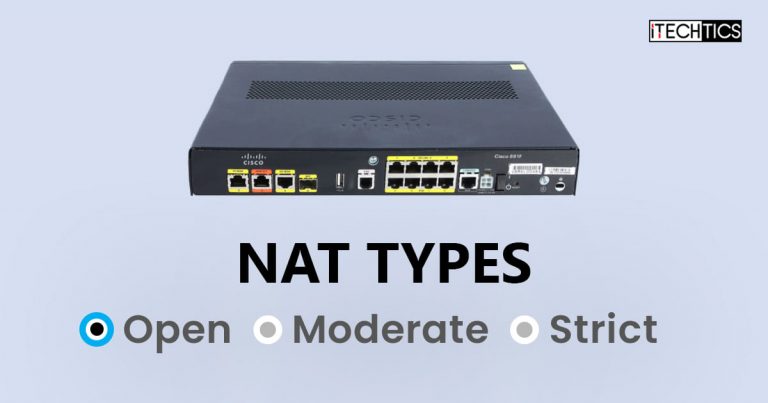Suppose you are experiencing internet connectivity problems on your PC, or notice that the internet seems to be working fine but is taking too long for match-making whilst gaming, or is just too laggy. In that case, the problem may not be your internet bandwidth, but the protocols set on your router.
The Network Address Translation (NAT) protocol applied to your router has different types. Each of these types can have a different impact on how fast your data packets are processed, and then forwarded (or blocked). If they are blocked, or take significant time to be processed, then it is likely that you will face lag, distorted internet connectivity, and even a drop in FPS while playing a game.
Today, we are going to discuss the different NAT types and how they function, determine which one is best suited for you, then see different methods on how to change your NAT type on your router as well as on your Windows PC.
Table of Contents
What is NAT in Networking?
Network Address Translation (NAT) is a method that translates multiple private IP addresses to a single public IP address.
Each device with a network card will have a unique IP address within your network, something like “192.168.0.3.” However, since these devices need to communicate with the internet, they are “translated” via the router to a unique public IP address. Now multiple devices are sending and receiving data over the internet using the same public IP.
What are NAT Types?
NAT types are defined by how strict or lenient the translation policies implemented on your router are. Briefly, they are categorized into 3 options:
- Open/ NAT type 1
- Moderate/ NAT type 2
- Strict/ NAT type 3
Since there is no universal name for these types, these are either defined by their policy settings, or labeled as 1, 2, and 3.
Let us see how each of these NAT types differs from each other and which one is best suited for you since they all have their pros and cons.
Open/ NAT Type 1
The “open” NAT type is the one with the most lenient policies applied. There are zero restrictions whatsoever, which means that no packets and data are processed or checked, and all network traffic is allowed in and out. It also means that the router has no firewall enabled.
This means that your data can move in and out of your local network without any hindrances. However, it also means that there is no check-and-balance in place to protect your network from attacks and malicious data. Therefore, we do not recommend to our readers that they apply NAT type 1, regardless of the internet’s performance.
Moderate/ NAT Type 2
This NAT type applies a few policies where it closes the ports and only leaves a few open. However, some ports may still be required to open manually. That said, NAT type 2 also has the firewall enabled, making your network relatively secure. Of course, this has its drawbacks.
With the firewall enabled and the policies implemented, it will take a bit longer for the packets to be processed and then forwarded. This causes some delay, resulting in a slower internet experience.
Strict/ NAT Type 3
This NAT type is the most secure of the three. The policies implemented in this type restrict incoming data unless allowed explicitly, which makes your local network much safer. the strict Nat type is usually enabled by default on most modern routers.
Due to this, you may experience sluggishness while online, or playing online games. Furthermore, this can also make your online match-making take longer since you can only discover people with the “Open” NAT type.
This brings us to the table below where you can see users with different NAT types only able to connect with other users having the specific NAT configuration:
| Open | Moderate | Strict | |
| Open | ✓ | ✓ | ✓ |
| Moderate | ✓ | ✓ | |
| Strict | ✓ |
From the table above, you can see that an “Open” NAT type can discover other devices that have either “Open,” “Moderate,” or “Strict” NAT types. However, a person having a “Strict” NAT type can only discover devices with “Open” NAT types.
Let us now see how to change the NAT type so you can optimize your network settings and make your internet speed faster.
How to Change NAT Type
Change NAT Type from Router
One method to change your NAT type is through the router’s Universal Plug and Play (UPnP) settings. It may be possible that it has been disabled, making your NAT type “Strict.” However, you can enable UPnP and change these settings.
What is Universal Plug and Play (UPnP)?
UPnP is a protocol that allows or blocks the devices on your network from being discoverable to one another. When this setting is enabled, the apps, games, and services running on your computer will be able to communicate to the router which ports to open so that it can send and receive data over the internet smoothly.
Regardless of whether you are using a Play Station, Xbox, a Nintendo, or a PC; enabling UPnP will allow all of these devices to open the respective ports on the router for the games which use them.
Of course, enabling UPnP has its security risks. For example, malware on your computer can be registered as a legitimate application, and if that malware sends a request to the router to open a port, it will be successful.
That said, here is how to enable UPnP on your router:
Note: To perform these steps, you need to have the administrative credentials to your router’s configuration portal.
-
Using any web browser, type in the IP address of your router in the address bar.

Enter the router’s IP address If you do not know its IP address, it can usually be found on the backside of the router (unless changed explicitly).
-
Next, provide the credentials to log into the portal and sign in. By default, these can also be found on the backside of the router (if not changed).

Enter credentials and log in -
Once logged in, look for the “UPnP” settings page. It can usually be found under “Settings,” “Network Settings,” or “Advanced Settings.”

Access UPnP settings -
Here, enable UPnP and then save the new configuration.

Enable UPnP -
Now restart your router.
Enable Port Forwarding on Router
Port Forwarding is an application of NAT. It is the redirection mechanism that translates TCP / IP packets from one destination to another.
Port forwarding is the forwarding of ports and not the complete IP addresses. For example, a computer with the IP address 192.168.0.2 sends packets designated for 192.168.0.4:8080 (where 8080 is the destination port). However, the router in between decides to forward the port to 192.168.0.4:433. Thus, the packet is redirected to another port of the same computer. This is the concept of port forwarding.
In this case, we can use the same concept to forward ports to a different IP address.
Port forwarding, if used correctly, can also be used to speed up your internet. This is because when a packet is transmitted with the destination information within the packet header, it still needs to perform searches on the internet, go through many gateways, and search for the correct path.
However, when port forwarding is enabled on the routers it is going through, the path will already be predefined, saving the packet seconds, and resulting in a faster internet response.
You can use this technique to get quick access to the game servers, ensuring their connection is quicker and more reliable.
The steps given below direct how to enable port forwarding on your router. But before you begin, make sure that you have the public IP address and port number for the game(s) that you want to configure it for. Moreover, ensure that your computer has a static IP address configured so it does not change in the future. Only then will port forwarding be successful.
Learn which ports to use for Port Forwarding.
-
Using any web browser, type in the IP address of your router in the address bar.

Enter the router’s IP address -
Next, provide the credentials to log into the portal and sign in. By default, these can also be found on the backside of the router (if not changed).

Enter credentials and log in -
Once logged in, look for the “NAT” settings page. Some routers may have a “Port forwarding” page.
-
Here, click Add to make a new entry to the port forwarding table.

Add new NAT entry -
On the next page, enter the details for your port forwarding configuration.
This usually includes the following information:
- Incoming interface.
- predefined or a custom service.
- * Machine IP address (Your local IP address).
- Protocol for use (TCP or UDP)
- External port start and end.
- Internal port start and end.

Enter port forwarding details -
Once the configuration is done, save the changes and then restart the router.
Use Hotspot with VPN on Windows PC
If you do not have access to your router or do not want to change its configuration, you can use a Virtual Private Network (VPN) on your Windows computer, then enable the Hotspot, and connect your device to it wirelessly as a workaround.
Using VPNs automatically bypasses any configurations on the physical router. This means that your Windows PC will disregard any policies implemented on the router, and instead follow the ones configured within the VPN software.
Once the VPN is installed and configured, you can then turn on the device’s hotspot and then wirelessly connect any device to change its NAT type. Using this technique will change the device’s NAT type to Moderate.
Here is how to achieve this:
-
Navigate to the following on your Windows 11/10 computer:
Settings app >> Network & internet >> Mobile hotspot
-
Here, change “Share my internet connection from” to Wi-Fi, and then toggle the slider in front of “Mobile hotspot” in the On position.

Enable hotspot -
Now go to the following:
Settings app >> network & internet >> VPN
-
Click Add VPN.

Add a VPN -
In the popup window, enter the details for the VPN connection and click Save.

Configure VPN -
Now back on the VPN settings page, click Connect in front of the VPN connection you just added.

Connect to VPN -
Once the device is connected via VPN, you can now connect the other devices to your computer’s hotspot. This will change their NAT type to Moderate.
Adopting this method will not require you to access the router’s configuration. However, only the devices connected to your PC’s hotspot will be able to change their NAT type.
This method is probably not the most convenient one but gets the job done if you do not have the credentials for your router.
Closing Thoughts
One method to change your NAT type that we did not explicitly mention in this post is by configuring a Demilitarized Zone (DMZ). A DMZ creates an unrestricted zone where all information and data are accessible by the public, which significantly increases the risks of threats and attacks on the internet.
DMZs are where a company may host a website that can be accessed by anyone, after which they secure their internal data and servers behind a firewall. It does not make sense to configure a DMZ on your router to be accessible by the public and makes your NAT type open.








